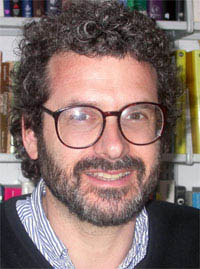Swarthmore Commencement Address
May 2006
Neil Gershenfeld '81

|
||
After all, becoming a physicist at Swarthmore was something of an accident for me. Or two accidents actually. First was getting in. I went to a rather unremarkable public high school; my real intellectual life was at home, debating my parent's arbitration cases over the dinner table. As a result, my academic record was equally unremarkable. Swarthmore was the only school that admitted me, and that was because I was just good enough of a swimmer to be recruited by a Division III swim team like Swarthmore's.
At Swarthmore, I found an intellectual life that was like a giant version of the dinner table at home. I started out studying philosophy, intending to ask deep questions about the nature of existence. Meanwhile, in my physics classes, bouncing balls and sliding elephants didn't appear to raise profound epistemological issues, but these seemingly mundane questions were uncovering deeper and deeper implications about the nature of nature. Plus there was the occasional opportunity for explosions, like the time I accidentally wired an LED without limiting the current and it sailed across the room.
However, I didn't see myself devoting my life to integrating equations of motion. When it came time to declare a major, I struggled with choosing to become a physicist. I mentioned this to a classmate, who simply asked "what else is there?" He was right; there really was nothing else possible for me. I came out of the physics closet, and spent happy hours working in the lab in the basement of the physics building. At the time, some schools did laboratory demonstrations. Others would provide lab equipment, along with instructions on how to do an experiment. At Swarthmore, we were given the apparatus and told to fix it.
In retrospect, this is one of the most important life lessons that I learned at Swarthmore. When I later arrived at some of the world's great research institutions, I found colleagues who were masters of capabilities that I didn't even know enough to dream about when I was at Swarthmore, but far fewer of them who would instinctively toss out the manuals and even the tools and ask how they should work rather than how they do work.
As I went on to make computerized musical instruments and molecular quantum computers and personal fabricators, I was driven by the kind of imperative I found at Swarthmore to see what could be rather than what is. Most recently, our research on digital fabrication has led my colleagues and me to create a global network of field fab labs. The passionate response we've seen from ordinary people when they get access to modern means for making things suggests that invention itself can be the most enabling kind of aid.
Returning now to Swarthmore where I learned about the power and pleasure of invention, I'm struck by how far the scientific facilities here have come. While I do wonder if they still have enough broken things left to fix, there's no shortage of things that are broken elsewhere on the planet. So, as you head out into that world, I encourage you to throw out the manual and fix it.